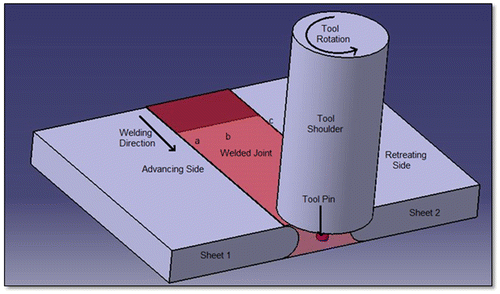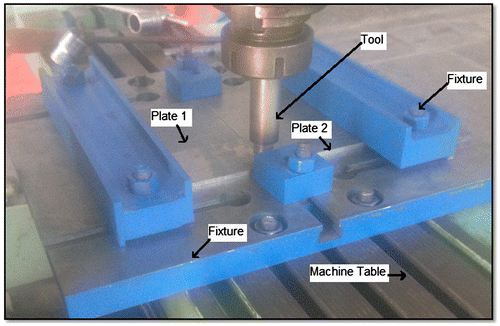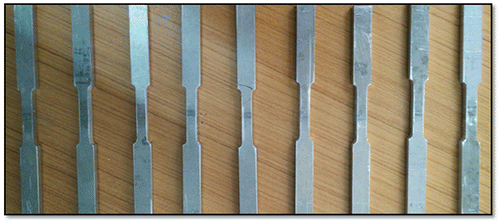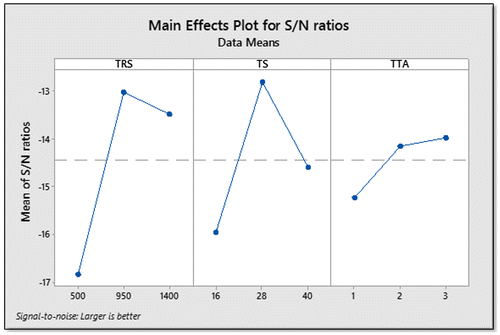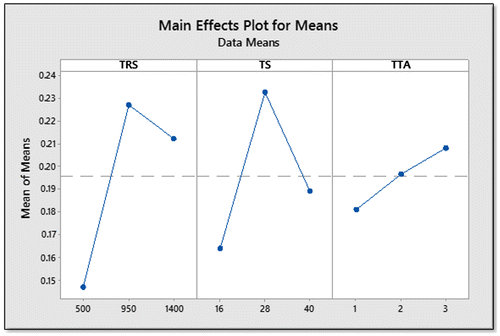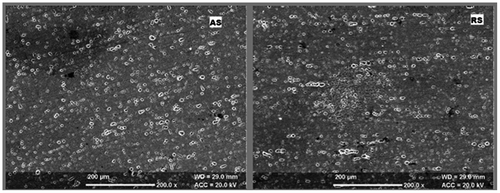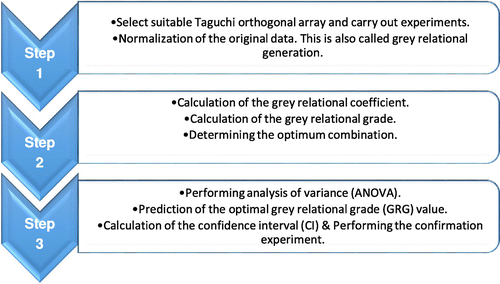Abstract
In present experimental work, friction stir welding of aluminium alloy 5083- H321 is performed for optimisation of process parameters for maximum tensile strength. Taguchi’s L9 orthogonal array has been used for three parameters – tool rotational speed (TRS), traverse speed (TS), and tool tilt angle (TTA) with three levels. Multi-response optimisation has been carried out through Taguchi-based grey relational analysis. The grey relational grade has been calculated for all three responses – ultimate tensile strength, percentage elongation, and micro-hardness. Analysis of variance is the tool used for obtaining grey relational grade to find out the significant process parameters. TRS and TS are the two most significant parameters which influence most of the quality characteristics of friction stir welded joint. Validation of predicted values done through confirmation experiments at optimum setting shows a good agreement with experimental values.
Introduction
Friction stir welding was first time used in year 1991 for laboratory research work at TWI, United Kingdom. But the process of joining two aluminium sheets through friction stir welding was so revolutionary that it captured the instant focus of the welding experts and industrialists. Friction stir welding provided the best key solution for all the experts who were facing difficulty for joining aluminium and its alloys at higher temperature (Kevorkijan, Citation2002). Aerospace industry and modern automobile industry got new opportunities to have a relook for better use of the most available metal on earth. Now a days, flow of expertise in friction stir welding and maximum use of resources with minimum waste make friction stir welding process more valuable and more automatic joining process (Praveen & Yarlagadda, Citation2005).
Friction stir welding is a process of joining two metal sheets in semi-solid state with the use of a rotating tool shoulder and a pin which stir material under the tool shoulder. Frictional heat is induced between the two upper surface edges which increase temperature up to re-crystallisation temperature of the two sheets. The used welded sheets may be of same or dissimilar materials. Mechanism of friction stir welding process is shown in Figure . There are two sides of the welding, during clockwise rotation of the tool and forward feed, left side is called advancing side and right side is called retreating side. During welding joint, three zones are formed named as (a) thermo-mechanical affected zone, (b) nugget zone, (c) heat-affected zone which have been represented in Figure .
The solid state welding produces welded joint without melting of material sheets; therefore, a number of defects e.g. porosity, cracking, blow holes which appear during conventional fusion welding process are avoided (Cavaliere, Citation2013; Kevorkijan, Citation2002; Khodaverdizadeh, Mahmoudi, Heidarzadeh, & Nazari, Citation2012; Kundu & Singh, Citation2016; Taban & Kaluc, Citation2006). In friction stir welding, high temperature below the melting point is attained through friction between tool shoulder and joining sheets as well as frictional heat produced by tool pin and the semi-solid material through the plastic flow of materials under the tool shoulder. Effect of different parameters on welding joint strength has been investigated by many researchers (Aydin, Tutar, Durmuş, Bayram, & Sayaca, Citation2012; Bagheri Hariri, Gholami Shiri, Yaghoubinezhad, & Mohammadi Rahvard, Citation2013; Kumar & Kailas, Citation2008; Verma & Misra, Citation2015). Taguchi with grey relational analysis has been used by many researchers in their respective fields for optimisation of processes (Ghetiya, Patel, & Kavar, Citation2016; Kasman, Citation2013; Kesharwani, Panda, & Pal, Citation2014; Singh & Kumar, Citation2006a, 2006b). GRA for friction stir welding has been used rarely, as the process has been used in aviation industry and marine industry therefore optimisation of the process is very essential for having good factor of safety at different applications.
Experimental set-up
A non-consumable tool with a concave shoulder and a flat face cylindrical pin has been used for the friction stir welding. Tool steel H-13 material has been used for the rotating tool and two sheets of aluminium alloy 5083-H321 have been welded through friction stir welding process. The used material AA 5083 consists of main measured alloying elements and as by American Society of Metals (ASM) has given in Table . The each sheet dimensions are 150 mm3 × 75 mm3 × 4.5 mm3 and the edges of each sheet have been properly cleaned and made distortion free for the proper alignment of the two mating edges. Concave shoulder with diameter 18 mm has been used with a pin diameter 6 mm and pin length 4.3 mm. Three parameters – tool rotational speed (TRS), traverse speed (TS), tool tilt angle (TTA) – have been selected for investigation based on review of literature and some pilot study. The selected process parameters with their three levels are given in Table . Input force, initial tool feed time and some other parameters have been kept constant during experimentation.
Table 1. Chemical composition of aluminium alloy AA5083-H321.
Table 2. Input process parameters and their levels.
Taguchi-based grey relational analysis has been used through selection of L9 orthogonal array. Ultimate tensile strength, hardness, and percentage elongation are the most important measures to ascertain the quality of the butt welded joint. Grey relational analysis has been used to get the maximum values of output variables. Orthogonal array L9 experimental plan is given in Table .
Table 3. Experimental plan through L9 orthogonal array.
Experiments have been conducted on a suitably modified vertical milling machine of Bharat Frit Warner make. A fixture has been fabricated for the proper holding of workpiece on the milling machine table. Friction stir welding components and the arrangement of plates have been shown in Figure .
For the testing of FSW butt welded joint, tensile test specimens were prepared in transverse direction as per ASTM E8M-04 module. Prepared tensile test specimens are shown in Figure . All the samples are tested at room temperature at a 40 kN Universal Testing Machine. Ultimate tensile strength test results are presented in Table . Vickers’ hardness tests have been performed for better micro-hardness. Percentage elongation and micro-hardness testing results are also given in Table .
Table 4. Average response values of different responses.
Taguchi approach and grey relational analysis
Many researchers have used different statistical tools for optimisation study of friction stir welding process. Taguchi approach is one of the most useful techniques for single response optimisation studies used for a number of engineering problems (Ghetiya, Patel, & Kavar, Citation2016; Gupta & Kumar, Citation2013; Kuram & Ozcelik, Citation2013; Singh, Raghukandan, & Pai, Citation2004; Tosun, Citation2005). In the present scenario of rapid manufacturing and cost reducing with maximum utilisation, complex processes have several quality characteristics. In such situations, several multi-response optimisation techniques are needed and the Taguchi-based grey relational analysis has been used in the present work.
Grey relational analysis was developed by Ju-Long (Citation1982). Grey system works like a black box concept where known and unknown factors are put together to get optimised responses. Grey relational analysis uses normalisation of data to calculate grey relational coefficients and grey relational grades. It calculates optimum arrangement and Analysis of Variance (ANOVA) is applied for the prediction of optimum grey relational grades as given by Flow Chart .
Ultimate tensile strength, micro-hardness, and percentage elongation of FSWed joint are very important quality factors. All these characteristics are of ‘larger-the-better’ type and their maximum values are sought simultaneously.
First step is to create grey relational generation with values between 0 and 1. This generation is achieved for all the three quality characteristics – smaller-the-better, larger-the-better, and nominal the best. For the current investigation, all the selected quality characteristics are of the type ‘larger the better’ and grey relational generation is calculated by Equation (Equation1(1) ) (Çaydaş & Hasçalık, Citation2008; Ju-Long, Citation1982; Kumar, Balaji, & Prrithvi, Citation2014):
(1)
where is reference series or sequence; max
and min
are maximum and minimum values in the sequence;
is the sequence generated after data processing.
i = 1, 2, 3, …, m; and k = 1, 2, 3, …, n; m is number of experiments and n is number of experimental data.
Now grey relational coefficients have been calculated with the respective deviation calculations as given in Equations (Equation2(2) ) and (Equation3
(3) ) (Çaydaş & Hasçalık, Citation2008; Ju-Long, Citation1982):
(2)
(3)
where is deviation series of reference series
and compatibility series
; ζ is identification coefficient, which is generally taken .5 when parameters are given equal weightage.
Grey relational coefficient for each experiment of L9 orthogonal array has been calculated through Equation (Equation3(3) ). The last step of calculation of grey relational grade is performed for calculating the relationship strength between reference series and compatibility series. Its value varies between 0 and 1. Higher value of GRG shows better relation and it is considered as an ideal case. Grey relational grade is the average summation of grey relational coefficients. It is calculated by following Equation (Equation4
(4) ) (Çaydaş & Hasçalık, Citation2008; Ju-Long, Citation1982):
(4)
where γi is a grey relational grade of ith experiment and n is number of performance characteristics.
Larger value of GRG indicates that the corresponding experimental results are closer to the ideal value or normalised value.
Results and discussion
Calculation of signal-to-noise ratio
Average values of all the responses have been reported in Table with the input parameter settings. In the first part of analysis signal-to-noise ratios for all three responses have been calculated. As mentioned earlier, higher values of UTS, VH and percentage elongation give better welding performance; therefore, Equation (Equation5(5) ) was used for the calculation of S/N ratio. Three iterations of the responses have been performed through mechanical testing. The FSW joint testing results with S/N ratios are given in Table .
(5)
Table 5. S/N ratios of different responses.
where n is number of experiment replications and yijk is the response variable value of the ith performance characteristic in the jth experiment at the kth trial.
Data processing and calculation of deviation sequence
The next part of analysis is to normalise S/N ratio of each response using Equation (Equation1(1) ). The S/N ratios are presented in Table . Calculations of experiment 1 for UTS, EL and VH are given below:
For calculating grey relational coefficients, the deviation sequences were determined; however discussed calculations appear to be presented in Table . For experiment 1, deviation sequence as determined from Equation (Equation2(2) ) is given below:
Table 6. Sequences of responses after data processing and deviation sequence
Estimation of grey relational coefficients and grades
The deviation sequences as given in Table were used for estimation of GRCs through Equation (Equation3(3) ). The distinguished coefficient (ζ) has been assigned a generalised value .5 for all performance characteristics. For calculating GRCs, Equation (Equation3
(3) ) has been used and estimated values of GRCs and GRGs have been reported in Table . The sample calculation for Experiment No. 1 is given below.
Table 7. Estimation of GRCs and GRGs.
All the values of GRCs for all nine experiments have been calculated using Equation (Equation1(1) ).
GRGs for all performance characteristics were determined using Equation (Equation4(4) ). The weightage for performance characteristics UTS, EL, and VH are .5, .3, .2, respectively. Grey Relational Grade for experiment 1 is calculated as:
All nine experiments’ GRCs have been used for calculating GRGs through Equation (Equation4(4) ).
All the values of GRGs randomly vary between 0 and 1. As the value of grey relational grade is reached maximum, it represents strong relation between reference sequence and comparability sequence.
The present investigation of optimisation of the complex multiple response characteristics of friction stir welding has been transformed into simple optimisation of single grey relational grade. Taguchi approach is best suited for single response optimisation in form of grey relational grade. The grey relational grade values corresponding to the three levels of the selected process parameters and the main effects in terms of grey relational grade are reported in Table .
Table 8. Grey relational grade for all three levels.
Estimation of optimum levels of input process parameters
After calculation of average value of GRG for each level of the process parameters, the maximum value of GRG is selected for each process parameter. Table presents the bold values of GRG which represent the maximum values among the three levels for each process parameter. These values correspond to TRS of 950 rpm, TS of tool of 28 mm/min, and TTA of 3° for better performance characteristics as shown in Figure . It is revealed from the figure that the optimum values of process parameters give the maximum values of GRG (Figure ).
Implementation of ANOVA
ANOVA is implemented to establish the significance and contribution of each process parameter to the grey relational grade value. Table represents ANOVA results and the percentage contribution of each factor.
Table 9. ANOVA results for grey relational grade.
Tabulated F-ratio at 95% confidence level is 3.2296. As seen from the ANOVA table, there are two process parameters – TRS and TS – which are having 55.18% and 36.64% contribution on GRG. TTA has an insignificant contribution of 5.63% on the GRG value.
The significant parameters and their optimal level selection indicate that plastic flow of material under the tool plays an important role for higher joint strength. Proper mixing of materials makes FSW joint more efficient; in other words, heat generation is an important characteristic which is responsible for joint strength. During lower heat generation, two welded materials remain separate resulting in poor joint strength. The higher heat generation is also a reason for poor joint strength because higher heat makes grain growth or second phase grains of larger size due to which size of heat-affected zone becomes large resulting in decrease in tensile strength and micro-hardness. Higher tool TS also produces low-quality weld. These situations lead to different defects like pinholes, cracks, etc. in the welding zone (Ghetiya et al., Citation2016; Kasman, Citation2013).
Optimal grey relational grade value prediction and calculation of CI
After calculation of optimum value for each quality characteristic, optimal grey relational grade value has been calculated using Equation (Equation6(6) ) for prediction and verification of improvement in GRG (Çaydaş & Hasçalık, Citation2008; Ju-Long, Citation1982).
(6)
The predicted optimum values are listed in Table . The value of γe is calculated .2770 from above equation. To check the reliability of predicted GRG, Confidence Interval (CI) is also determined using Equation (Equation7(7) ) (Çaydaş & Hasçalık, Citation2008; Ju-Long, Citation1982).
(7)
Table 10. Actual and predicted values of grey relational grade.
where is F ratio at α% level of significance; R is the number of confirmation tests; Ve is error mean squares and neff is effective number of replications.
Here R is having value 3, total no of experiments (N) = 9,
, for 95% confidence level
.
The calculated value of lies between .2270 and .3270. The comparison of actual GRG and predicted GRG has been depicted in Figure .
Confirmation experiments and GRG linear mathematical model
For the verification of predicted GRG, a confirmation experiment was performed. The average values of UTS, %EL, and micro-hardness obtained are reported in Table with the standard values of AA5083-H321 as per ASM data sheet.
Table 11. Standard and measured values of Mechanical Properties of AA5083-H321.
The joint efficiency is calculated 94.6 % as compared to base material tensile strength. The friction stir welding joint at the optimised parameter setting has been shown in Figure .
SEM testing of the confirmation experiment reveals that high compactness of the small grains around the centre weld line provides higher strength. Microstructure of AS and RS side of the nugget zone has been shown in Figure .
During the friction stir welding, the plastically deformed soften region has been replaced through the small equiaxed microstructure grains.
The general linear model for GRG has been established through mathematical regression analysis of three parameters at three levels given in Equation (Equation8(8) ). A data-set of predicted GRG has been created through the developed linear model as reported in Table . The error difference between actual and predicted values is – 8.52 to 6.02. The adequacy of developed mathematical model is tested using R2 value which falls between 0 and 1.
(8)
Current mathematical model has R2 value 97.46% which is near to 1. Such a high value of R2 indicates a good correlation between actual values and predicted values of GRG.
Conclusions
In the present research study, Taguchi L9 orthogonal array has been used for multi-response optimisation through grey relational analysis. Friction stir welding process parameters have been optimised through Taguchi-Grey Relational Approach using grey relational grade. The following conclusions have been drawn from this study:
| • | Grey relational analysis reveals that optimum values of process parameters for Maximum ultimate tensile strength and higher micro-hardness are TRS 950 rpm, TS 28 mm/min, and TTA 3°. | ||||
| • | The percentage contributions of TRS and TS in affecting the GRG value are 55.18 and 36.64, respectively, as evidenced by ANOVA. | ||||
| • | Confirmation experiments show that the actual values of the selected characteristics at the optimal setting of the process parameters lie within the predicted range of the characteristics at the selected level of confidence. | ||||
| • | Present investigation suggests that the complex optimisation of multi-response problems can be easily simplified through Taguchi-based grey relational analysis. | ||||
Disclosure statement
No potential conflict of interest was reported by the authors.
Acknowledgement
The authors would like to acknowledge National Institute of Technology, Kurukshetra, India for providing requisite facilities to accomplish this work.
References
- Aydin, H., Tutar, M., Durmuş, A., Bayram, A., & Sayaca, T. (2012). Effect of welding parameters on tensile properties and fatigue behavior of friction stir welded 2014-T6 aluminum alloy. Transactions of the Indian Institute of Metals, 65, 21–30.10.1007/s12666-011-0069-6
- Bagheri Hariri, M., Gholami Shiri, S., Yaghoubinezhad, Y., & Mohammadi Rahvard, M. (2013). The optimum combination of tool rotation rate and traveling speed for obtaining the preferable corrosion behavior and mechanical properties of friction stir welded AA5052 aluminum alloy. Materials & Design, 50, 620–634.10.1016/j.matdes.2013.03.027
- Cavaliere, P. (2013). Friction stir welding of Al alloys: Analysis of processing parameters affecting mechanical behavior. Procedia CIRP, 11, 139–144.10.1016/j.procir.2013.07.039
- Çaydaş, U., & Hasçalık, A. (2008). Use of the grey relational analysis to determine optimum laser cutting parameters with multi-performance characteristics. Optics & Laser Technology, 40, 987–994.
- Ghetiya, N. D., Patel, K. M., & Kavar, A. J. (2016). Multi-objective optimization of FSW process parameters of aluminium alloy using taguchi-based grey relational analysis. Transactions of the Indian Institute of Metals, 69, 917–923.10.1007/s12666-015-0581-1
- Gupta, M., & Kumar, S. (2013). Multi-objective optimization of cutting parameters in turning using grey relational analysis. International Journal of Industrial Engineering Computations, 4, 547–558.
- Ju-Long, D. (1982). Control problems of grey systems. Systems & Control Letters, 1, 288–294.10.1016/S0167-6911(82)80025-X
- Kasman, S. (2013). Multi-response optimization using the Taguchi-based grey relational analysis: A case study for dissimilar friction stir butt welding of AA6082-T6/AA5754-H111. The International Journal of Advanced Manufacturing Technology, 68, 795–804.10.1007/s00170-012-4720-0
- Kesharwani, R. K., Panda, S. K., & Pal, S. K. (2014). Multi-objective optimization of friction stir welding parameters for joining of two dissimilar thin aluminum sheets. Procedia Materials Science, 6, 178–187.10.1016/j.mspro.2014.07.022
- Kevorkijan, V. (2002). Economic benefits of the substitution of traditional cast iron and steel by aluminium and magnesium based material in automotive segment. Metalurgija, 8, 251–258.
- Khodaverdizadeh, H., Mahmoudi, A., Heidarzadeh, A., & Nazari, E. (2012). Effect of friction stir welding (FSW) parameters on strain hardening behavior of pure copper joints. Materials & Design, 35, 330–334.10.1016/j.matdes.2011.09.058
- Kumar, K., & Kailas, S. V. (2008). On the role of axial load and the effect of interface position on the tensile strength of a friction stir welded aluminium alloy. Materials & Design, 29, 791–797.10.1016/j.matdes.2007.01.012
- Kumar, S. S., Balaji, V. N., & Prrithvi, P. M. (2014). Influence of residual stress on stress intensity factor estimation of multiple cracks in a dissimilar welded joint. Procedia Engineering, 86, 234–241.10.1016/j.proeng.2014.11.033
- Kundu, J., & Singh, H. (2016). Friction stir welding of dissimilar Al alloys: Effect of process parameters on mechanical properties. Engineering Solid Mechanics, 4, 125–132.10.5267/j.esm.2016.2.001
- Kuram, E., & Ozcelik, B. (2013). Multi-objective optimization using Taguchi based grey relational analysis for micro-milling of Al 7075 material with ball nose end mill. Measurement, 46, 1849–1864.10.1016/j.measurement.2013.02.002
- Praveen, P., & Yarlagadda, P. K. D. V. (2005). Meeting challenges in welding of aluminum alloys through pulse gas metal arc welding. Journal of Materials Processing Technology, 164–165, 1106–1112.10.1016/j.jmatprotec.2005.02.224
- Singh, H., & Kumar, P. (2006a). Optimizing feed force for turned parts through the Taguchi technique. Sadhana, 31, 671–681.10.1007/BF02716887
- Singh, H., & Kumar, P. (2006b). Optimizing multi-machining characteristics through Taguchi’s approach and utility concept. Journal of Manufacturing Technology Management, 17, 255–274.10.1108/17410380610642304
- Singh, P. N., Raghukandan, K., & Pai, B. C. (2004). Optimization by Grey relational analysis of EDM parameters on machining Al–10%SiCP composites. Journal of Materials Processing Technology, 155–156, 1658–1661.10.1016/j.jmatprotec.2004.04.322
- Taban, E., & Kaluc, E. (2006). Microstructural and mechanical properties of double-sided MIG, TIG and friction stir welded 5083-H321 aluminium alloy. Metallic Material, 44, 25–33.
- Tosun, N. (2005). Determination of optimum parameters for multi-performance characteristics in drilling by using grey relational analysis. The International Journal of Advanced Manufacturing Technology, 28, 450–455.
- Verma, S., & Misra, J. P. (2015). A critical review of friction stir welding process. DAAAM International Scientific Book, Chapter 22, 249–266.

